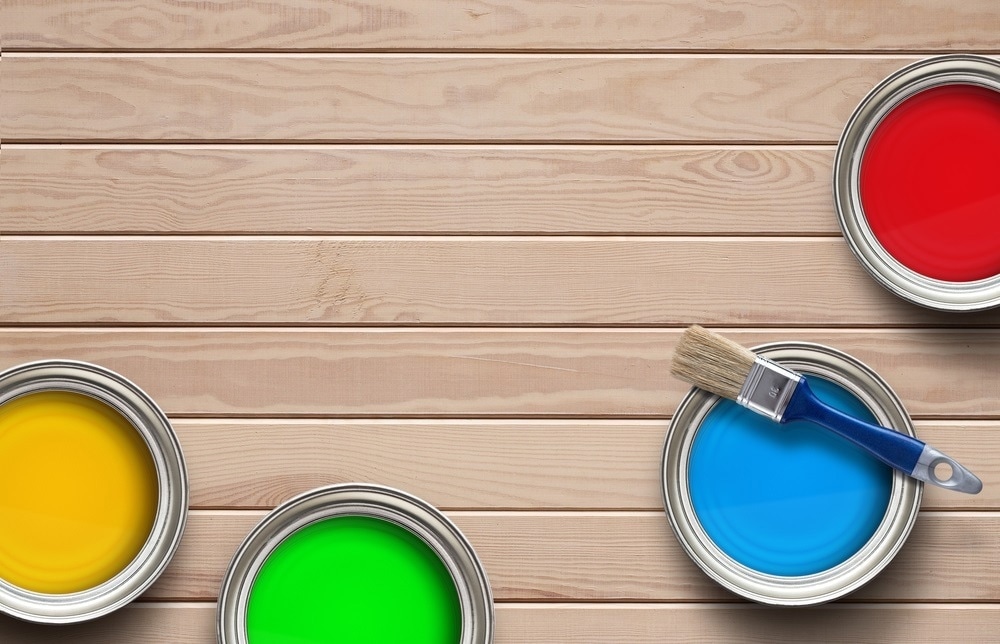Paints are applied onto both porous (plaster walls) and non-porous (car bodies) substrates. Also they may be applied in many ways, such as brushing, spraying, roller coating and dip coating. In most instances, the paint is required to give a smooth (glossy) coating on the substrate and thus be anesthetically pleasing to the customer.

Image Credits: rangizzz/shutterstock.com
The formation of this smooth surface is dictated by both the rheological and surface tension properties of the materials. The predominance of the influential properties depends on the porosity of the substrate and whether the surface is vertical or horizontal.
This article describes how rheological experiments can be used to give information on the performance characteristics of the paints.
Colloidal Dispersions
Paints are colloidal dispersions of solid particles (dispersed phase) in liquid (dispersion medium). The dispersed phase will contain pigment particles and may also contain extender particles (e.g. for opacity modification), flow modifier particles and latex particles (for binder purposes). The dispersion medium will contain solvent and may also contain polymer or resin (for binder purposes). The type of application will determine the relative amounts of each of these components in the final formulation.
In such concentrated dispersions, small changes will have a significant effect on the rheological behavior of the paint. Modern rheometers can be used to give information on processing and storage/stability, as well as performance characteristics.
Description Of The Problem
When a paint is applied to a substrate it will have striations in its surface caused by, for example, the bristles of a brush or the force of the air gun during spraying. After application, the striations need to flow out in order to form smooth surface - this process is known as leveling.
However, if the paint is being applied to a vertical surface, the paint cannot flow too much as this will result in sagging. This may manifest itself in 'tear-drops' being left behind in the dried paint film. This indicates that the paint should possess well balanced viscoelastic properties. On the one hand, after the paint has been sheared during application, it should have predominantly fluid-like behavior to allow leveling to occur.
On the other hand, at some point, the paint should re-structure to avoid sagging occurring, i.e. it becomes solid-like.
Rheological Analysis
All of the experiments reported in this article were performed on a Bohlin rheometer.
Stress Viscometry
Figure 1 shows the curves for two paints - a non-drip gloss (ndg) and a gloss finish (gf) - which have been analyzed using stress viscometry. In this experiment a stress is applied to the material and the resultant shear rate is measured. The viscosity is calculated using the simple relationship:
viscosity = shear stress/shear rate
The stress is increased stepwise during the experiment and the shear rate is measured at each stress. The curves show a number of interesting points about the properties of the two paints:
a) in the low shear region the viscosity of the ndg is much higher than that of the gf paint
b) the ndg paint shear thins at a much higher stress than the gf paint, and much more dramatically,
c) the ndg paint shear thins to a lower high shear viscosity than the gf paint.

Figure 1. Stress Viscometry On ndg And gf Paints.
The ease of structure breakdown of the ndg paint means that it is more likely to flow in to the bristles of a paint brush when it is dipped into the paint. Also, the lower high shear viscosity of the ndg paint means that it will be easier to apply than the gf paint. In order to avoid sedimentation it is necessary to build into the paint a high low shear viscosity. This enables the paint to withstand the force of gravity causing particles to sediment. As can be seen from the curves in Figure 1, the ndg paint is more likely to be stable than the gf paint.
Pre-shear Oscillation
Figures 2 (a) and 2 (b) shows the viscoelastic response of the materials after rotational shear. In the experiment, the material is sheared at a reasonable high shear stress to simulate the process of being brushed on to the substrate (pre-shear). The shear is ceased and the material is subjected to an oscillatory low stress (at a fixed frequency) to simulate the structure re-build which occurs in the paint.
It is important that the paint flows sufficiently to allow leveling to occur, but not so much that sagging occurs (see earlier). In terms of the rheological properties of the material, this means that immediately after shear the viscous modulus (G") should dominate the elastic modulus (G'), but at some finite timescale, G' should dominate G".

Figure 2(a). Non-drip Gloss, Presh Oscn At 20deg.

Figure 2(b). Gloss Paint, Presh Oscn At 20deg.
The curves indicate that the ndg paint (Figure 2 (a)) should exhibit good leveling and sag properties, while the gf paint (Figure 2 (b)) would also show good leveling but excessive sag behavior. However, the rheological experiment does not allow for either absorption of the carrier solvent into the substrate (e.g. a plaster wall) or evaporation of the carrier solvent after the paint has been brushed out to a thin film, which would change the rheological properties quite markedly and have a large influence on the structure re-build properties of the paints.
Summary
These two simple experiments yield a lot of useful information about the performance behavior of paint systems. They are quantitative, reproducible and non-subjective, in contrast to some of the more traditional tests used in the coatings industry. The tests could form the basis of both quality control and development protocols.

This information has been sourced, reviewed and adapted from materials provided by Malvern Panalytical.
For more information on this source, please visit Malvern Panalytical.